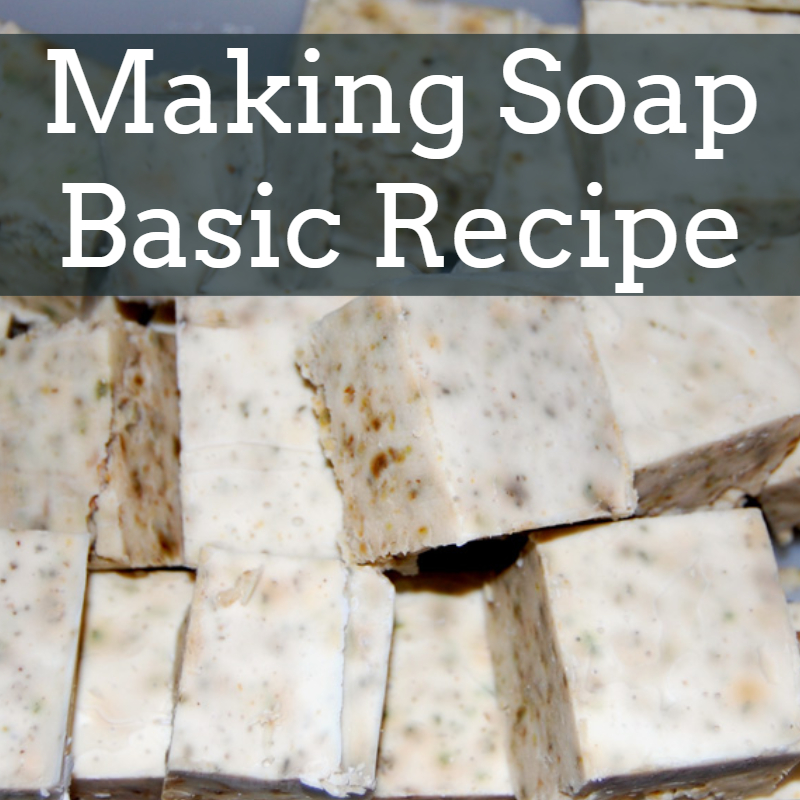I’ve been making soap for years now. I’m not too fancy about it. I usually make this basic recipe with the addition of essential oils and/or oatmeal. I do not claim to be a soap making expert, but I’ve made this recipe many times and it’s never failed to produce good quality soap.
This recipe will make about 10 nice sized bars. You can double the recipe to make a larger batch.
- Coconut Oil – 225 gr. | 7.9 oz. | 25%
- Crisco Shortening – 180 gr. | 6.3 oz. | 20%
- Olive Oil – 450 gr. | 15.9 oz. | 50%
- Castor Oil – 45 gr. | 1.6 oz. | 5%
- Distilled Water – 297 gr. | 10.5 oz.
- Lye – 126 gr. | 4.4 oz.
Weighing the Base Ingredients – get them all ready.
NOTE: In soap making, you should WEIGH the ingredients. Accuracy matters in soap making!
Prepare the lye solution.
Weigh your water and place it in a bowl.
Put on safety equipment; (lye is very caustic – you don’t want to get it on you anywhere!)
- goggles,
- gloves and
- long sleeve clothing.
Weigh the sodium hydroxide (lye) beads or flakes and pour them slowly into the water.
Always add the sodium hydroxide (lye) to the water. NOT the water to the sodium hydroxide. Otherwise, you could have a violent reaction…kind of an explosive thing.
Be sure to stir the water as you pour the lye beads .and keep stirring until the lye beads are completely dissolved.
You will notice fumes being produced while you are mixing the lye solution. Sufficient ventilation is a good idea.
The fumes are noxious….avoid breathing them in. I’ve never had mine be that bad….just don’t have your face/head over the bowl.
Prepare the base oils.
Starting with the solid oils, weigh each and place it into the stainless steel pot.
Place the pot on the element and set the temperature to medium-low. As you continue to weigh the rest of the oils, the solid oils will melt.
Once the solid oils have melted and before putting the liquid oils into the pot, remove the pot from the element. Add the liquid oils.
Check temperatures.
The goal is to get the temperatures of both the oil mixture and the lye solution to approximately 90-95 degrees Fahrenheit or 32-35 degrees Celsius.
If needed, the lye solution can be heated/cooled in a hot/cold water bath in the sink, and the oils can be heated on the element or cooled in a cold water bath.
Getting the oil mixture and lye solution to temperature can be tricky at first but it gets easier as you develop a feel for how long it takes the lye to cool.
Step 4 – Mixing the Lye and Oils
This is probably one of the most confusing steps when you’re learning how to make cold process soap.
“How do I know how long to mix for?” and “What is this ‘trace’ that everyone is referring to?” are a couple of the common questions asked.
In answer to the first question – It can take anywhere from about 5 minutes to hours and hours. The ingredients you use will determine how long you must mix for. Most of my cold process recipes take about 5 to 10 minutes to trace using a stick blender and whisk alternately.
The second question is answered by the picture below. If you start to see stirring trails on the top of the soap base, you have reached ‘trace’. This is very similar to when you make pudding. At first, the pudding is very runny but as you mix, it becomes thicker and thicker.

I made a video showing me making “Goat Milk Soap”. It’s a little different than the recipe in this post, but it might be helpful to watch if you’re thinking of trying this out. My Goat Milk Soap Making video.

